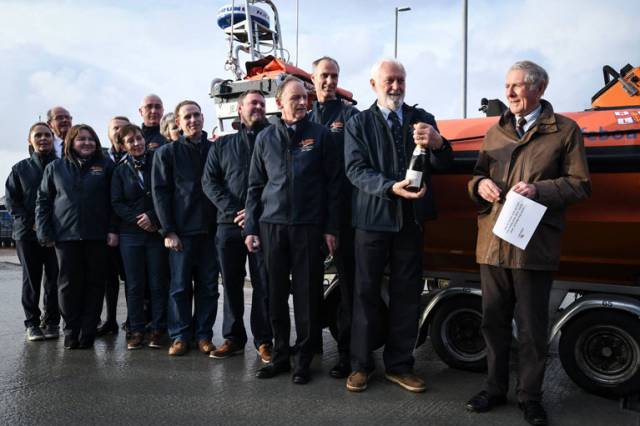Lough Derg RNLI’s new lifeboat, the Atlantic 85 B911 Jean Spier arrived at the Station yesterday.
On Saturday, November 10, the Naming Ceremony for the new lifeboat, the Jean Spier, took place at the RNLI Lifeboat College at Poole in the south of England. The new lifeboat was donated to the charity by Robert and his late wife Jean Spier and, having identified Lough Derg RNLI as a station in need of a new lifeboat, the RNLI have put the lifeboat on service on Lough Derg.
Naming Ceremony
Volunteer crew from Lough Derg RNLI and members of the Lough Derg RNLI Fundraising Committee travelled to Poole for the ceremony. Remaining crew stayed at home to provide cover the lifeboat in the event of a Shout.
John McCallion, Head of Internal Construction opened the ceremony with a warm welcome to all guests. Robert Spier, the donor and wife of Jean Spier then handed the lifeboat into the care of the RNLI.
In 2016 Robert and Jean Spier, active supporters of the RNLI, intended that together they would donate a new lifeboat to the charity, and were delighted when the Lough Derg B class became available to support. Sadly, Jean died in October 2017 and Robert Spier is dedicating the new lifeboat, an Atlantic 85 B911 'Jean Spier' in her name. Lough Derg RNLI Lifeboat Station is the fortunate recipient of this new boat.
Niamh McCutcheon, an RNLI Irish Council Member and Chairperson of Lough Derg Fundraising Committee, accepted the lifeboat on behalf of the RNLI before handing it into the care of Lough Derg RNLI. Mrs. McCutcheon thanked Robert and Jean for “so generously agreeing to fund this lifeboat following your many years of fundraising for the RNLI” and extended an open invitation to Mr. Spier to come to Dromineer to visit the station and crew.
To the delight of everyone present The Wareham Whalers, The Dorset Shanty Crew performed ‘Home from the Sea’, a song beloved by all lifeboat crew, as part of their performance.
Accepting the lifeboat on behalf of the volunteer crew of Lough Derg, Liam Maloney, Lifeboat Operations Manager said ‘how proud we are to get this state of the art lifeboat for our station and also to express how grateful and humbled we are by the extremely generous gift from you Robert and your late wife Jean’. Of the lifeboat, Mr. Maloney commended the designers and builders and said that the new lifeboat ‘promises quicker response times with more space for casualty recovery and is able to carry more crew during training exercises. But most importantly for Launch Authorities waiting anxiously at the station, we have radar to guide our crews home on dark nights and in foggy conditions’. Mr. Maloney read a poem, ‘Lifeboat’ especially composed for the occasion by Eleanor Hooker, a volunteer helm and poet.
Lifeboat
for Robert Spier, i.m. Jean Spier
We drop anchor off Vikings Landing,
run engines astern ‘til Elsinore holds fast
due east of Inis Cealtra. Against standing
waves, and wind that harps the masts
pitched in the harbour – crew name land in sight,
list the ways of water, recount Ophelian acts that bore
us to the lake’s darkest stage, and, in failing light,
as a low mist rolls over the Hare, and hounds rain before
a squall, we weigh anchor and make for home one final time
in Elsinore, grateful for a new Atlantic to this inland sea –
no longer will we fear the fog’s fret, that mimes
a snow-blind clime inside our eyes, now, when we leave the quay,
four up, our Jean Spier will signal those in peril, or in strife,
that we her volunteers may do our work – carry home, save a life.
Later, Liam presented Robert Spier with a framed chart of Lough Derg, and showed him the location of the lifeboat station and places referenced in the poem.
On behalf of all at Lough Derg RNLI, Aoife Kennedy, Administrative Officer for Lough Dergh RNLI, presented Robert Spier with a card made for the occasion and signed by all the volunteers at the Station, and a commissioned woolen throw, embroidered with 'Lough Derg RNLI Jean Spier' in one corner, made by Brian Hanly (a former Deputy Launching Authority) at his Hanly's Woollen Mills.
John McCallion, Head of Internal Construction and Refit of the RNLI ALB fleet, gave the volunteers from Ireland a great tour of the lifeboat factory.































































